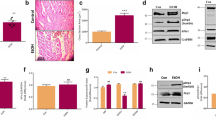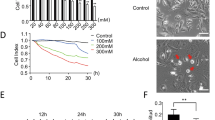Abstract
Background
Cardiomyocyte apoptosis plays an important role in alcoholic cardiac injury. However, the association between calcium-sensing receptor (CaSR) and alcohol-induced cardiomyocyte apoptosis remain unclear. Therefore, we investigated the role and its moleculer mechanism of CaSR in rat cardiomyocyte apoptosis induced by alcohol.
Methods
Alcohol-induced cardiomyocyte apoptosis in vivo and in vitro model of rats were applied in this study. The expression of CaSR, endoplasmic reticulum stress markers and apoptosis were tested by immunohistological staining, western blot, TUNEL and flow cytometry, respectively. [Ca2+]i were detected by confocal laser scanning microscopy.
Results
Compared with the control group, alcohol intake (AI) led to abnormal arrangements of cardiomyocytes and obvious increase of myocardial apoptosis. Moreover, AI also significantly upregulated protein expression of CaSR, GRP94, caspase-12 and CHOP. Alcohol induced apoptosis of cultured cardiomyocytes of rats in a dose-dependent way. Activation of CaSR markedly enhanced cardiomyocyte apoptosis and ERS induced by alcohol, ERS inducer also significantly increased cardiomyocyte apoptosis without activating CaSR. Furthermore, GdCl3 augmented alcohol-induced increase of [Ca2+]i in cardiomyocytes, which was attenuated by NPS2390 but not 4-PBA pre-treatment.
Conclusions
Alcohol could induce cardiomyocyte apoptosis in rats in vivo and in vitro, which was mediated probably via activating CaSR, and then ERS and the increase of the cytosolic [Ca2+]i. This provides a potential target for preventing cardiomyocyte apoptosis and cardiomyopathy induced by alochol.






Similar content being viewed by others
References
Steiner, J. L. & Lang, C. H. (2017). Etiology of alcoholic cardiomyopathy: mitochondria, oxidative stress and apoptosis. The International Journal of Biochemistry & Cell Biology, 89, 125–135.
Movva, R., & Figueredo, V. M. (2013). Alcohol and the heart: to abstain or not to abstain? International Journal of Cardiology, 164(3), 267–276.
Regula, K. M., & Kirshembaum, L. A. (2005). Apoptosis of ventricular myocytes; a means to an end. Journal of Molecular and Cellular Cardiology, 38(1), 3–13.
Thomas, A. P., Sass, E. J., & Tun-Kirchmann, T. T., et al. (1989). Ethanolinhibits electrically-induced calcium transients in isolated rat cardiac myocytes. Journal of Molecular Cellular Cardiology, 21(6), 555–565.
Li, S. Y., & Ren, J. (2008). Cardiac overexpression of alcohol dehydrogenase exacerbates chronic ethanol ingestion-induced myocardial dysfunction and hypertrophy: role of insulin signaling and ER stress. Journal of Molecular and Cellular Cardiology, 44(6), 992–1001.
Fernández-Solà, J., Fatjó, F., & Sacanella, E., et al. (2006). Evidence of apoptosis in alcoholic cardiomyopathy. Human Pathology, 37(8), 1100–1110.
Jankala, H., Eriksson, C. J. P., & Eklund, K. K., et al. (2002). Combined calcium carbimide and ethanol treatment induces high blood acetaldehyde levels, myocardial apoptosis and altered expression of apoptosis-regulating genes in rat. Alcohol and Alcoholism, 37(3), 222–228.
Xin, W., Li, X. Y., & Lu, X. C., et al. (2011). Involvement of endoplasmic reticulum sress-associated apoptosis in a heart failure model induced by chronic myocaridal ischemia. International Journal of Molecular Medicine, 27(4), 503–509.
Liu, M., Wang, X. R., & Wang, C., et al. (2013). Panax quinquefolium saponin attenuates ventricular remodelling after acute myocardial infarction by inhibiting chop-mediated apoptosis, Panax quinquefolium saponin. Shock, 40(4), 339–344.
Schroder, M., & Kaufman, R. J. (2005). The mammalian unfolded protein response. Annual Review of Biochemistry, 74, 739–789.
Reddy, R., Mao, C., & Baumeister, P., et al. (2003). Endoplasmic reticulum chaperone protein GRP78 protects cells from apoptosis induced by topoisomerase inhibitors: role of ATP binding site in suppression of caspase-7 activation. Journal of Biologcal Chemistry, 278(23), 20915–20924.
Breckenridge, D., Germain, M., & Mathai, J., et al. (2003). Regulation of apoptosis by endoplasmic reticulum pathways. Oncogene, 22(53), 8608–8618.
Scorrano, L., Oakes, S. A., & Opferman, J. T., et al. (2003). BAX and BAK regulation of endoplasmic reticulum Ca2+: a control point for apoptosis. Science, 300(5616), 135–139.
White, C., Li, C., & Yang, J., et al. (2005). The endoplasmic reticulum gateway to apoptosis by Bcl-X(L) modulation of the InsP(3)R. Nature Cell Biology, 7(10), 1021–1028.
Wang, M., Yao, Y., & Kuang, D., et al. (2006). Activation of family C G-protein coupled receptors by the tripeptide glutathione. Journal of Biological Chemistry, 281(13), 8864–8870.
Brown, E. M., Vassilev, P. M., & Quinn, S., et al. (1999). G-protein-coupled, extracellular Ca2+ -sensing receptor: a versatile regulator of diverse cellular functions. Vitamins and Hormones, 55, 1–71.
Lin, K. I., Chattopadhyay, N., & Bai, M., et al. (1998). Elevated extracellular calcium can prevent apoptosis via the calcium-sensing receptor. Biochemical and Biophysical Research Communication, 249(2), 325–331.
Wang, R., Xu, C. Q., & Zhao, W. M., et al. (2003). Calcium and polyamine regulated calcium-sensing receptors in cardiac tissues. European Journal of Biochemistry, 270(12), 2680–2688.
Zhang, W. H., Fu, S. B., & Lu, F. H., et al. (2006). Involvement of calcium-sensing receptor in ischemia/reperfusion-induced apoptosis in rat cardiomyocytes. Biochemical and Biophysical Research Communication. 347, 872–881.
Wang, L. N., Wang, C., & Lin, Y., et al. (2008). Involvement of calcium-sensing receptor in cardiac hypertrophy- induced by angiotensinII through calcineurin pathway in cultured neonatal rat cardiomyocytes. Biochemical and Biophysical Research Communication, 369(2), 584–589.
Qi, H., Cao, Y., & Huang, W., et al. (2013). Crucial role of calcium-sensing receptor activation in cardiac injury of diabetic rats. PLoS One., 8(5), e65147.
Han, G., Wang, H. Y., & Han, Z. W., et al. (2018). Relationship between CaSRs and LPS-injured cardiomyocytes. International Journal of Clinical and Experimental Pathology, 11(4), 1965–1971.
Liu, W. X., Zhang, X., & Zhao, M., et al. (2015). Activation in M1 but not M2 macrophages contributes to cardiac remodeling after myocardial infarction in rats: a critical role of the calcium sensing receptor/NRLP3 inflammasome. Cell Physiology and Biochemistry, 35, 2483–2500.
Fogle, R. L., Lynch, C. J., & Palopoli, M., et al. (2010). Impact of chronic alcohol ingestion on cardiac muscle protein expression. Alcoholism: Clinical and Experimental Research, 34(7), 1226–1234.
Ieda, M., Tsuchihashi, T., & Ivey, K. N., et al. (2009). Cardiac fibroblasts regulate myocardial proliferation through beta1 integrin signaling. Developmental Cell, 16(2), 233–244.
Olson, E. R., Shamhart, P. E., & Naugle, J. E., et al. (2018). Angiotensin II-induced extracellular signal-regulated kinase 1/2 activation is mediated by protein kinase c delta and intracellular calcium in adult rat cardiac fibroblasts. Hypertension, 51(3), 704–711.
Kartkaya, K., Kanbak, G., & OGlakci, A., et al. (2014). Protective effect of calpain inhibitor N-acetyl-L-leucyl-L-leucyl-L-norleucinal on acute alcohol consumption related cardiomyopathy. Molecular Biology Reports, 41(10), 6743–6753.
Fernández-Solà, J., Lluis, M., & Sacanella, E., et al. (2011). Increased myostatin activity and decreased myocyte proliferation in chronic alcoholic cardiomyopathy. Alcoholism Clinical and Experimental Research, 35(7), 1220–1229.
Zhang, B., Turdi, S., & Li, Q., et al. (2010). Cardiac overexpression of insulin-like growth factor 1 attenuates chronic alcohol intake-induced myocardial contractile dysfunction but not hypertrophy: roles of Akt, mTOR, GSK3beta, and PTEN. Free Radical Biology and Medicine, 49(7), 1238–1253.
Stewart, A., Maity, B., & Anderegg, S. P., et al. (2015). Regulator of G protein signaling 6 is a critical mediator of both reward-related behavioral and pathological responses to alcohol. Proceedings of the National Academy of Sciences USA, 112(7), E786–E795.
Raymond, A. R., Becker, J., & Woodiwiss, A. J., et al. (2016). Ethanol-associated cardiomyocyte apoptosis and left ventricular dilation are unrelated to changes in myocardial telomere length in rats. Journal of Cardiac Failure, 22(4), 294–302.
Guo, J., Li, H. Z., & Zhang, W. H., et al. (2010). Increased expression of calcium-sensing receptor induced by ox-LDL amplified apoptosis of cardiomyocyts during stimulated ischaemia-reperfusion. Clinical and Experimental Pharmacology and Physiology, 37(3), e128–e135.
Zhang, R. H., Gao, J. Y., & Guo, H. T., et al. (2013). Inhibition of CYP2E1 attenuates chronic alcohol intake-induced myocardial contractile dysfunction and apoptosis. Biochimica et Biophysica Acta, 1832(1), 128–141.
Lu, F. H., Fu, S. B., & Leng, X. N., et al. (2013). Role of calcium-sensing receptor in cardiomyocyte apoptosis via the sarcoplasmic reticulum and mitochondrial death pathway in cardiac hypertrophy and heart failure. Cellular Physiology and Biochemistry, 31(4-5), 728–743.
Oyadomari, S., Koizumi, A., & Takeda, K., et al. (2002). Targeted disruption of the chop gene delays endoplasmic reticulum stress-mediated diabetes. The Journal of Clinical Investigation, 109(4), 525–532.
Gan Rt, Hu. G. X., & Zhao, Y. J., et al. (2012). Post-conditioning protecting rat cardiomyoctes from apoptosis via attenuating calcium sensing receptor-induced edo(sarco)plasmic reticulum stress. Molecular and Cellular Biochemistry, 361(1-2), 123–134.
Kaufman, R. J. (2002). Orchestrating the unfolded protein response in health and disease. Journal of Clinical Investigation, 110(10), 1389–1398.
Lu, F., Tian, Z., & Zhang, W., et al. (2010). Calcium-sensing receptors induce apoptosis in rat cardiomyocytes via the endo(sarco) plasmic reticulum pathway during hypoxia/reoxygenation. Basic and Clinical Pharmacology and Toxicology., 106(5), 396–405.
Nakagawa, T., Zhu, H., & Morishima, N., et al. (2000). Caspase-12 mediates endoplasmic reticulum-specific apoptosis and cytotoxicity by amyloid-beta. Nature, 403(6765), 98–103.
Jo, D. G., Jun, J. I., & Chang, J. W., et al. (2004). Calcium binding of ARC mediates regulation of caspase 8 and cell death. Molecular and Cellular Biology, 24(22), 9763–9770.
Hajnóczky, G., Buzas, C. J., & Pacher, P., et al. (2005). Alcohol and mitochondria in cardiac apoptosis: mechanisms and visualization. Alcoholism: Clinical and Experimental Research, 29(5), 693–701.
Xu, J., Zhou, Q., & Xu, W., et al. (2012). Endoplasmic reticulum stress and diabetic cardiomyopathy. Experimental Diabetes Research, 2012, 827971.
Ferri, K. F., & Kroemer, G. (2001). Organelle-specific initiation of cell death pathways. Nature Cell Biology, 3(11), E255–E263.
Acknowledgements
The authors thank Feng XIN, Lijuan YAN and Liping LIU for the technical work in this research. This work was supported by the National Natural Science Foundation of China (81370319, 81700318).
Author Contributions
W.L. designed research and wrote the paper; W.L., M.Z. and X.Z. performed research; W.L., J.C. and X.Z. analysed data and revised the manuscript; Y.L. and X.Y. supervised the experiments, revised and approved the manuscript.
Author information
Authors and Affiliations
Corresponding authors
Ethics declarations
Conflict of Interest
The authors declare no competing interests.
Ethical Approval
The authors are accountable for all aspects of the work.
Additional information
Publisher’s note Springer Nature remains neutral with regard to jurisdictional claims in published maps and institutional affiliations.
Rights and permissions
Springer Nature or its licensor (e.g. a society or other partner) holds exclusive rights to this article under a publishing agreement with the author(s) or other rightsholder(s); author self-archiving of the accepted manuscript version of this article is solely governed by the terms of such publishing agreement and applicable law.
About this article
Cite this article
Liu, W., Zhao, M., Zhang, X. et al. Alcohol Intake Provoked Cardiomyocyte Apoptosis Via Activating Calcium-Sensing Receptor and Increasing Endoplasmic Reticulum Stress and Cytosolic [Ca2+]i. Cell Biochem Biophys 81, 707–716 (2023). https://doi.org/10.1007/s12013-023-01167-8
Accepted:
Published:
Issue Date:
DOI: https://doi.org/10.1007/s12013-023-01167-8




